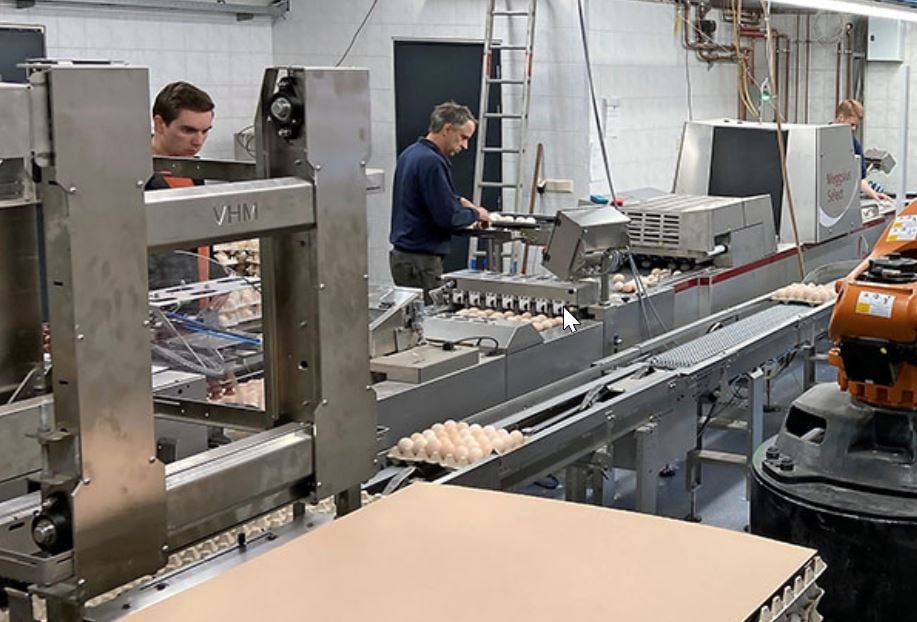The Netherlands - Broiler breeders Joan and Sonja van Haandel have been working with the Meggsius system for six months. It saves labour and the machine does a better job of selecting the eggs than people can. "It is relaxed working. For the person who collects the eggs, it has become more of an operator function."
Joan van Haandel already became interested in camera systems twenty years ago, after he had seen how tulips were graded automatically at a tulip grower's premises. However, such a system was not yet available for eggs. "I asked around in vain then, but two years ago I came into contact with Vencomatic Group, they were developing such a system."
This article is translated from an article on Boerderij.nl
Four modules
The Meggsius system from Vencomatic Group currently consists of four modules: the Meggsius Count for counting eggs, control system Meggsius Control, Meggsius Detect for signalling leaking eggs and Meggsius Select for automatic egg inspection and grading. Van Haandel purchased the complete system for his site in Mariaheide, where he keeps 50,000 parent broilers in eight houses. He outlines the developments in his farm. "First we had to collect the eggs from the nests manually, after that the collecting was automated. Then came a packing machine and this is the next step." Van Haandel wanted to show the system together with Vencomatic Group on two open days to fellow multipliers, but bird flu threw a spanner in the works.
Objective sorting
Van Haandel emphasises the importance of the right selection of eggs for a breeder. In a laying hen farm, the difference between first and second choice is not so big. "But with hatching eggs you are talking about a depreciation of 20 to 1 cent. Previously, two employees stood at the belt to sort and check. That was labour intensive and therefore expensive. "Grading eggs depends on the person standing at the belt," says Van Haandel. "I didn't want a subjective, but an objective sorting."
Self-learning
The Meggsius Select consists of a chimney with two cameras and a sorting unit. On the basis of entered criteria, it is determined whether the eggs meet the requirements. Eight pictures are taken per egg. In case of contamination the software measures the contamination, after which approval or rejection follows. The Select also sorts on deformities and weight. Initially, the system sometimes rejected suitable eggs and allowed unsuitable ones to pass through. What the Select ejects is checked manually. If, for example, there is a slight contamination, the egg is put back. "The machine is self-learning and is already better than a person. I am critical, I want to reach 100%. Then no one will have to stand on the belt anymore."
Constant flow of eggs
An additional advantage is the constant flow of eggs. The software ensures that the supply via the different belts is optimal by adjusting the speed. "There is an efficient supply, so the packing machine is always running. That is relaxing work, it gives everyone such a break. We have become more of an operator."
Because there is no longer a need for someone to constantly stand next to the belt, employees can perform other tasks. Van Haandel claims to have saved at least 25% on labour costs.
Camera inspection
The modules of the Meggsius system function independently of each other, but the Count and Control system, which controls the processes on the basis of programmed specifications, can only be used together. Meggsius Count is the first module of the production, explains Frank Bakermans of Vencomatic Group. It is a camera inspection system that counts the eggs just before they enter the transversal. The cameras also signal how many eggs are on the left and right side of the conveyor and because the system knows exactly how long the nest row is, it becomes clear where exactly in the house the production has taken place.
Bakermans states that the counting is done visually and not with infrared light, like in other systems. By placing a camera on the system egg belt, he says, it is prevented that eggs are counted twice or even three times before and after standstill. The third feature is the visual inspection of the transitions from one belt to the other. These are crucial for the quality of the egg. As a poultry farmer you always want to have this transition in sight, according to Bakermans.
Broken egg
The Meggsius Detect, which is positioned between the cross conveyor and the egg packer, detects leaking eggs. Van Haandel: "If an egg is broken, the belt is stopped. This prevents other eggs in the egg flow and the entire packing machine from being contaminated. That saves time." A warning lamp then comes on. The poultry farmer removes the broken egg and the dust with a cloth, after which he starts the belt again.
Dashboard
Vencomatic Group is still working on extensions and improvements. For instance, a dashboard will be developed, showing all collected data. Furthermore, Vencomatic Group is researching what the quality of the egg can tell about the health of the hen, so that action can be taken more quickly if something threatens to go wrong in the house.
Company Profile Van Haandel
Joan (53) and Sonja (51) van Haandel have eight houses with 50,000 broiler parent birds in Mariaheide, North Brabant. At this location they have been using the Meggsius egg counting, inspection and grading system since April this year. They use the system with all modules: Count, Control, Detect and Select.
In Vorstenbosch (N.-Br.), the company also has a rental site with three houses and 15,000 broiler parent birds. Van Haandel distinguishes itself through its strong focus on hygiene.












.png?width=160&height=132&name=Egg%20packers%20-%20Vencomatic%20Group%20(2).png)
.png?width=160&height=132&name=Meggsius%20Select%20-%20Vencomatic%20Group%20(2).png)











